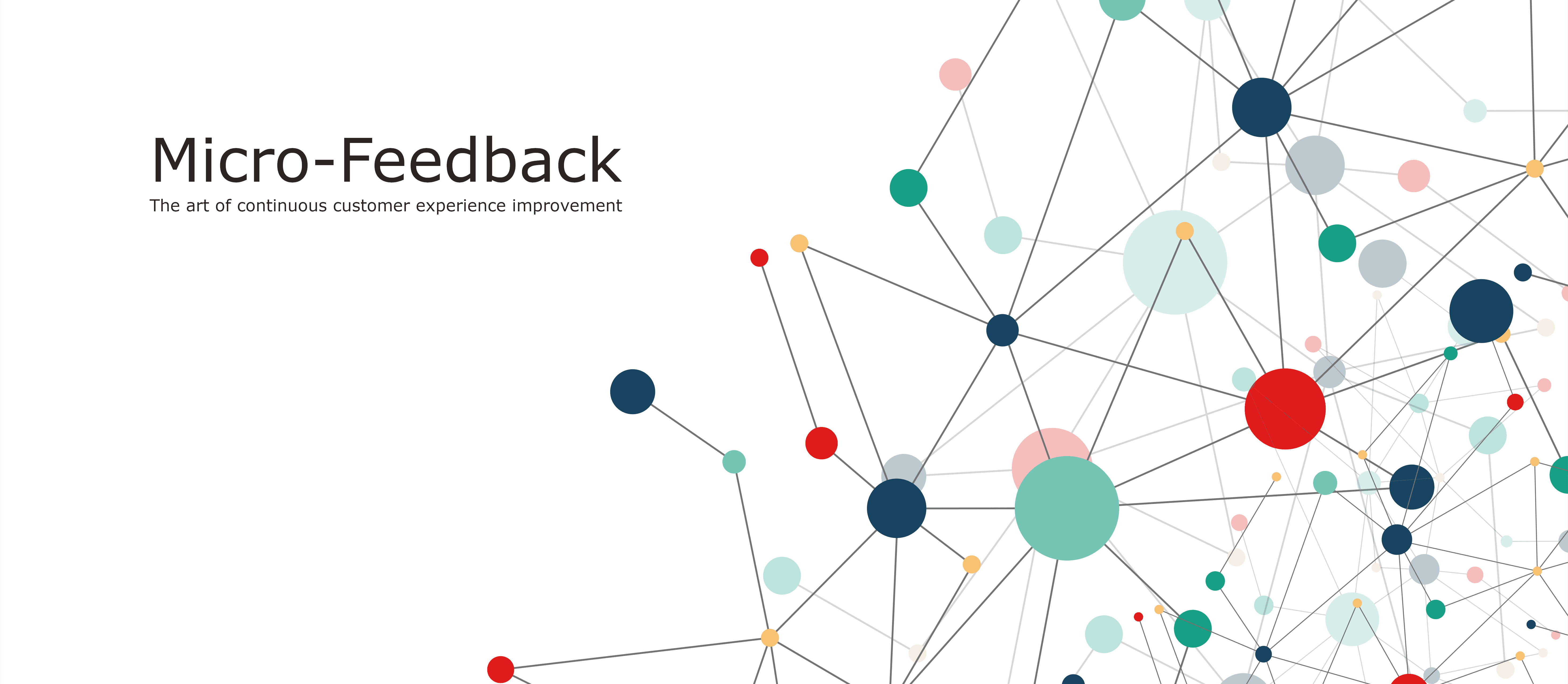
It's Time To Ditch The Long Surveys and Use Real-Time Micro Feedback
If you've ever played a role in the customer experience team, you probably have had a tough time gathering customer feedback. Let's face it: It's challenging to get customer feedback. It's a heavy lift. It takes time to find customers with similar experiences, and you have to find a channel to reach out to them.
When you give a link via an email or on a retail receipt to access a long survey, it means your customer has to take time out of their day to give their feedback. We all know that most customers are generally reluctant to fill out a lengthy survey, even with three questions! What ends up happening is the people who usually give you feedback through a traditional survey, if they complete it, are on the extremes, either positive or negative. They love you or hate you. That creates a lot of bias in your service and products. Then you've got the bell curve where the majority of your customers are in the middle, and they don't care enough either way to give you feedback.
Moreover, a lot of feedback is captured out of context using the traditional survey method. Suppose you send a customer a NPS (Net Promoter Score) style survey and ask specific questions about experiences distinct from the actual experience. In that case, they're giving you feedback with speculation, which might not be accurate and even misleading. So you get these low response rates, biased towards the extremes with low sample size, without the relevant context, and based on your customers' memory. This is not definitely what you are using to drive your strategic and long-term decisions.
One of the most significant shifts in the customer experience space is changing how you think about collecting feedback. You must always build the experience of collecting feedback to fit the customer needs, not your needs.
So why do you need to move away from traditional surveys that only take place days, weeks, or months after someone buys something or receives a service from you?
Long Surveys Do Not Match Current Usage Trends
We live in an interconnected world where 54.8% of online traffic is coming from mobile devices. People are now accustomed to interactions that are short, conversational and easy to do quickly. Long surveys are none of these things. Because of that fact, the response rate is going to be very low for long surveys. Recent reports shows that a response rate of 5%-30% is the usual for customer surveys. So is a 5% response rate considered good? Imagine only making 5% of your monthly sales. Would that be good to you?
You Want Repeat Customers, But Traditional Surveys Don't Give A Chance For Continual Feedback
Sending a long survey once at the end of a customer journey means that customers give you the overall impression they happen to remember. For example, if their last interaction with your business was negative, they might base all of their feedback on that. Regular surveys do not give you real-time data based on all interactions and do not give you the granularity you need.
You can improve your Customer Experience feedback management by integrating collecting feedback directly into your Customer Experience through micro-feedback. It's the little things that matter most in our lives. And micro-feedbacks are the little things that give you tremendously valuable insights into how your service is received by customers, which in turn decides the reputation of your business or service.
What is Micro-Feedback?
Micro-feedback is a form of customer satisfaction survey which collects customers' experience based on their very last experiment in an interaction point. While traditional surveys address a wide range of areas in a single questionnaire, the micro-feedback approach focuses on capturing the experience on a single point of interest, fresh and as it happens.
As the word suggests, the micro-feedback question focuses only on one touchpoint to accurately make the feedback more relevant to the specific experience and context. It will reflect the respondent's genuine feelings.
Trusted Responses
Not only should you receive more responses since the method is quick and easy for customers to use, but you'll also receive better quality responses since they are given at the time of their experience and specific touchpoints. It means the feedback should be captured in the context, right at the appropriate moment relevant to the recent customer experience.
If you aim to improve customer satisfaction and loyalty, then the micro-feedback approach could become an extremely valuable strategy to get a genuine idea about how customers feel about any specific aspect of your products and services.
Actionable Business Insights
The higher quality of data you receive makes it much easier to evaluate and create actionable business insights. Because all the data is real-time, it also means you aren't waiting weeks or months to see what your customer's experience is. Instead, the feedback is always available for you to review.
A traditional survey of multiple questions may turn out to be too heavy for many customers, and a majority of them are reluctant to take the required time. On the other hand, a micro-feedback strategy makes it incredibly easy to answer, and there will be an incredible response rate compared to a general survey questionnaire.
Why are you feeling like you can't give up on your long surveys?
Given the benefits of micro-feedback, what are the concerns raised to give up long surveys and keep steering clear of micro-feedback solution.
If All The Questions Are Quantitative, I Can't Get To Reasons Why
It's easy to feel frustrated when someone gives you a 0 (zero) for customer service without explaining why they had issues. It doesn't give you the feedback you need to improve the experience. In the world of micro-feedback, there's a myth that it can only be Quantitative based. Real-time feedback collection does not have to be just Quantitative feedback. It's very common for our clients to set up a Quantitative question followed by a Qualitative question to get details from the customer. With the advancements in sentiment and text analysis, our platform can then analyze those Qualitative answers to give you a high-level overview of the responses. You benefit from both feedback styles while making the analysis more efficient and keeping the entry process simple for users.
You Feel Like You Need All The Questions To Get To The Answers You Need
Long surveys often have built-in logic to give different questions based on responses, and some companies feel they need this flow to get to the root of the customer feedback. But, most likely, the more questions or layers of logic you add are just making your customers feel annoyed by the length of the survey. By collecting feedback through a micro-feedback method based on touchpoints in the customer journey, you get a clear picture of when the customer's experience may have hit an issue or where it improved. Our Experience Journey Map product allows you to aggregate all your feedback into different Customer Journey maps that give you that insight quickly and accurately.
What Are The Benefits of the Micro-Feedback Strategy?
Micro-feedback is a strategy that can be used daily due to its inherent simplicity. A customer wouldn't even notice that they are answering a survey question, and you can get invaluable leads and insights to improve your business. As the micro-feedback is collected at the point of experience, there's no need for the respondents to think too hard or remember things. Instead, they will express what they feel about the experience they just had, and those answers will reflect their honest ideas.
Let's summarize the important points to remember in implementing the micro-feedback approach.
Have a Clear Idea About Your Survey's Goals
Always make sure to work out what exactly you want to measure. Then ask a well-prepared yet simple question that can be answered without any effort. You may add an optional follow-up question based on the first answer, but that should be done in a very straightforward way, such as giving the customers some options regarding the "WHY" behind their responses.
Make It Simple and Fun to Answer
When the question is simple and fun, more people will be interested in responding. Make it as simple as possible so that the respondents won't feel that they are actually responding to a survey. And most importantly, make it fun to play. ABC choice answers or even emoticons would be great choices.
Ask for Feedback Without Being a Nuisance
In this micro-feedback method, you should wait for the right moment to get the response without disturbing your customers. Unlike the traditional survey-based method, the micro-feedback approach simplifies the feedback collection method and makes it as frictionless as possible for customers. In addition, using different means of feedback collectors in digital, voice, and physical channels help to not barge in on someone during her journey and instead be a part of it.
The short answer is that long surveys just don't cut it in modern customer experience feedback management. It's time to upgrade your feedback collection methods towards a micro-feedback model to match the experience that your customers expect. Not sure where to get started? We can help! Visit our Book a Demo page to set up a time with a member of our time to walk you through all the solutions we can offer you.



